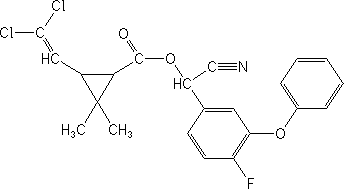| CYFLUTHRIN COMMON NAME: Cyfluthrin
OTHER NAME : Baythroid, Cyfloxylate, Solfac
CHEMICAL NAME: (RS)-a-cyano-4-fluoro-3-phenoxybenzyl (1RS, 3RS; 1RS, 3SR)-3-(2,2-dichlorovinyl)-2,2-dimethylcyclopropanecarboxylate
Or (RS)-a-cyano-4-fluoro-3-phenoxybenzyl (1RS)-cis-trans-3- (2,2-dichlorovinyl)-2,2-dimethylcyclopropanecarboxylate
STUCTURE FORMULA:

PHYSICAL AND CHEMICAL PROPERTIES: A.I. is white colorless
Crystal, (tech. is brown, oil, viscous mass, with crystalline parts). M.P.: ( ? ) 64
oC ; ( ? ) 81 oC ; ( ? ) 65 oC ; ( ? ) 106 oC ; (Tech., 60 oC ). V.p ( ? )9.6×10 -4 ;
( ? )1.4×10 -5 ; ( ? )2.1×10 -5 ; ( ? )8.5×10 -5 all in mPa, 20 oC . Hardly soluble in
water or other hydroxylic solvents, soluble in most of organic solvents.
Thermally stable at room temperature. In water DT50 for ? :36, 17, 7; ? :117,
20, 6; ? : 30, 11, 3; ? : 25, 11, 5 (all in days, pH 4, 7, 9 respectively, 22 oC )
TOXICOLOGY: Cyfluthrin is considered moderately toxic to mammals. The oral dose of cyfluthrin that resulted in mortality to half of the test animals (LD50) ranged from 869 - 1271 mg/kg in rats, 291 - 609 mg/kg in mice, >1000 mg/kg in sheep, > 100 mg/kg in dogs and > 1000 mg/kg in rabbits. In inhalation toxicity tests with rats, the concentration of cyfluthrin in air that resulted in mortality to half of the test animals (LC50) was >1,089 ug/l in 1 hour tests, and ranged from 469 - 592 ug/l in 4 hour tests. Although cyfluthrin is an irritant to human skin, especially facial skin, it is not considered to have high dermal toxicity. The dermal LD50 in tests with rats was > 5,000 mg/kg, and was not found to be a skin irritant or sensitizer in guinea pigs and rabbits.
FORMULATION AND SPECIFICATION:
Items |
95 Technical |
5EC |
Appearance |
Yellow to Brown even liquid |
Brown yellow transparent liquid |
Assay, % |
95.0 min |
5.0min |
Moisture, % |
0.3max |
0.3max |
Acid (H2SO4), % |
0.2max |
0.2max |
PACKING: 200kg in iron drum, or on the client's requirement
USES: An insecticide effective against many pests, especially Lepidoptera, Coleoptera, Homoptera and Hemiptera on cereals, cotton, fruits and vegetables; also against migratory locusts and grasshoppers For agricultural uses, applied at 15-40 g/ha. Used against Blattellidae, Culicidae and Muscidae in public health situations, stored products, domestic use and animals health. It has a rapid knockdown effect and long-lasting residual activity.
PRECAUTION :
• Do not use in mixture with other alkali pesticides.
• If swallowed, get medical attention. If on skin, wash with plenty of soap and water.
• Do not apply this product nearby lake, rivers, permanent streams, marshes or natural ponds. |


